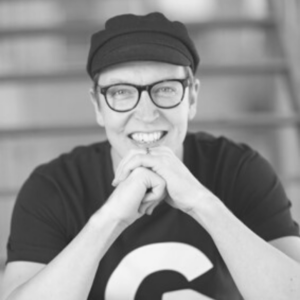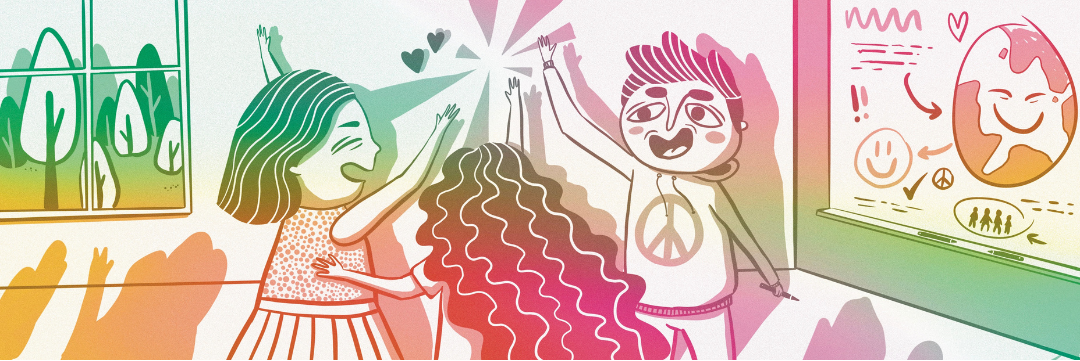
Mikko Mäkipää, Educational Specialist @GutsyGo
“Take a moment to think about how much energy and effort it takes for an army to conquer countries and nations. Think about what we are capable of. Compared to war, our actions for peace need to be even harder and go further. They need to reach people’s hearts.”
With this sentence I usually end the last day of the Gutsy Go coach training.
It has never been more adequate than it is now. Our understanding of peace and the need for peace education has drastically changed over the past few months. Peace education requires action. Action that is based on cooperation. Action that serves the common wellbeing instead of a personal need.
In the Finnish language, the word peace is related to taking it easy, not disturbing anyone. Basically “living in peace” can be understood as minding your own business.
But times change and issues become global; a crisis can burst into flame anywhere, as we have unfortunately been witnessing. Suddenly the attitude of “minding your own business” is out of date and simply not enough anymore.
Thirty years ago Finland was a key factor in connecting people around the world through mobile phones. Now our youth are doing it again, through brave actions for peace. Nearly four hundred teachers and youth workers have been trained to become Gutsy Go coaches and nearly four thousand teenagers have had the experience of building peace and positive interaction in their communities, both in Finland and Estonia.
Gutsy Go’s YouTube channel (https://www.youtube.com/c/GutsyGo/featured) features hundreds of examples by our youth on how to create solutions to resolve conflicts and bring people together in an inspiring way. The young people involved have been recognised and appreciated by several awards and over a million views through social media channels.
Invisible enemy
When we think about peace education, we need to first understand what the actual battle is for and what we are fighting against. Who is our actual enemy? At Gutsy Go, we have never believed in demonstrations or pointing fingers at something or someone; this shifts the responsibility of change to someone else. By putting yourself in a judging and shouting position, you end up on the outer circle highlighting the power structure.
At Gutsy Go, the youth do point out the grievances of our society, but the difference is that they create a solution for it right away, implement it practically and share it with the digital world. The question that highlights this difference is heard every week by youngsters who have their own doubts: “Are we really going to do this?” Followed by a confident coach who motivates and inspires them, replying calmly, “Yes we are.”
Concrete actions work as the catalyst of change as Sophie, 17, says: “My experience with Gutsy Go was the best ever. I have always liked to do good to others, but the week gave me the courage to do more concrete acts for peace. I wish the people responsible for the war would have had a Gutsy week as young people so that their understanding of peace would be different.”
Why is it done this way? Because in peace education, the enemy is not the politicians, bureaucracy or climate change. The invisible enemy is hiding in our minds. Our battles for peace are actually battles against cynicism. Let’s take a look at it from the researcher’s point of view.
Character strength enhances mental health
According to Pekka Mustonen, Managing Director of the Finnish Medical Society Duodecim, the number of cynical youth doubles between primary school and young adulthood. This means that the number increases from ten percent to twenty percent.1
Why is this number so alarming, you might ask?
The seriousness of this situation comes from the fact that cynicism leads to shorter life expectancy. A person’s attitude towards life and lack of hopefulness influence the choices they make.
Duodecim has been the research partner of Gutsy Go for several years, and their studies show promising results. The main finding is that a higher level of positive mental health is significantly associated with higher self-esteem, higher levels of character strength, such as hope and kindness, and a better experience of social inclusion. The findings highlight the role of enhancing adolescents’ psychological and social domains as potential routes for better mental wellbeing.2
In terms of the results, it seems that self-esteem, character strength and experience of social inclusion might have a stronger association with adolescents’ mental wellbeing than their family’s socioeconomic determinants.2 This result makes the work of every educator and pedagogue meaningful. By enhancing character strengths, we can overcome the effect of surrounding circumstances on mental health.
A very recent dissertation states that students’ usage of their personal strengths is related to their general happiness, both directly and indirectly via school-related happiness and school engagement.3
As Gutsy Go youngster Rafi Kabiri, 18, puts it: “When I look back on it now, I feel that Gutsy Go gave a direction to my life. I learned how to work with different people and appreciate them despite the situation they are in in that particular moment of their life. It has made me very thankful for everything I have and given me strength to work towards my goals in life.”
Duodecim is currently continuing their research at Gutsy Go Hub, where the method is implemented in everyday school life in three schools in a bilingual district in Southern Finland.
From passive object to active subject
During my twenty-year-long career in education, I have never witnessed such a massive and rapid behavioural change in youth. A couple of years ago we had a big operation in Oulu, a city in Northern Finland. We had many GG weeks in different parts of the city. After a GG week, the youth have the possibility to apply to become a Gutsy Spark. Sparks form a community of young people who have taken part in a GG week and want to continue with additional peace projects.
We gathered these Sparks in one place and, even though they didn’t know each other, through a shared experience of building peace, an extremely strong bond was established. The atmosphere was indescribable. It was comparable to an intense rock concert. The youth were passionate and willing to work together for peace. They were sparkling with self-confidence, a sense of meaningfulness and joy. This is how Annika, 18, describes her experience: “For me, the week was a journey of personal growth. It opened my eyes to the things that are important in life and what I want to do in the future. I joined Gutsy Sparks and found the way of life that I had been looking for.”
This experience affected my thinking on peace education, youth work and learning in general. As a special education teacher I have always struggled with the thought that our youth come to sit at a table that is too readymade. In my opinion, the problem is related to the lack of understanding as to why they have to go to school. My son’s reply to the question was maybe a bit sarcastic, but to point: “Because adults think we are stupid.”
I think that in youth work, we concentrate too much on pleasing or entertaining youth. This path does not lead to a happy place. Imagine the second day in an amusement park when the excitement is gone. More and more eventually becomes less. The potential of young people as makers of change should be utilised before it is wasted. According to Deloitte’s Millennial survey, more than eighty percent of youth consider it their mission in life to make the world a better place4 and eighty percent of youth want to help others but are not quite sure how to do it.5
Make peace visible
A quote by Nelson Mandela helps us understand the journey of youth: “There is nothing like returning to a place that remains unchanged to find the ways in which you yourself have altered.” This happens every time young people are given the opportunity and support to find a place where they and their skills are needed.
“As a Gutsy Spark and assistant coach, I have witnessed those magical moments as young peoples’ eyes open up to the world around them. A professional coach supports them with questions and lets them figure out as a group what they want to affect and how to deal with the situation,” Rafi Kabiri, 18, explains.
We can only imagine how it feels to return to school when you have been teaching IT skills in prison or taking elderly people out for a walk for the first time in months. Rafi reflects back to his own GG week: “It gave me a lot of self-confidence and the courage to meet new people. This has had a huge impact on my future.”
The collective process has also had a multifaceted impact on the adults and teachers who work as coaches. Building trust in youth and at the same time letting go of being in charge can be a totally new situation for many. During the week the coaches have the opportunity to notice and identify character strengths in their youth and celebrate together in the premiere. One comment by a teacher is persistent in my mind: “This was amazing; for a week I got to be a human.”
Use of media has many dimensions in Gutsy Go. It is used as a pedagogical tool; by making peace visible, character strengths are made visible, too. The premiere strengthens the experience of young people to be capable of doing good and building peace in a very short period of time. Additionally, the impact of the projects grows when the videos are shared online. The bullying experiment project reached over a million views and is widely used in schools as teaching material.
The last Gutsy Go week took place in the Lasnamäe area in Tallinn. I want to end this article with the voice of the youth. They were tasked with continuing the sentence “I want to live in a world…” and by the end of the week they had made ten projects dealing with those exact wishes. So, wherever you are, whatever you do, think about what kind of world you want to live in. Gather a group and create your own Gutsy project together.
Enjoy!
Find out more:
https://www.facebook.com/GutsyCollective
https://www.instagram.com/gutsycollective/?hl=fi
The cover image was designed by young Estonian artist Luisa Harjak.

